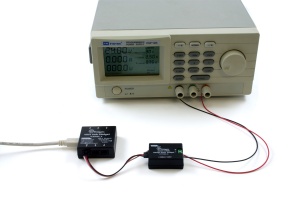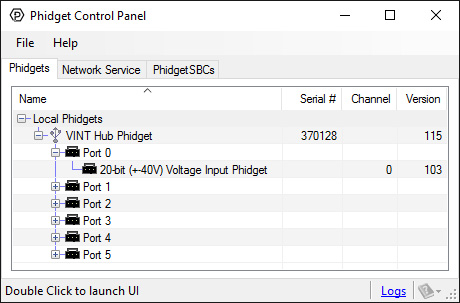VCP1000 User Guide

Required Hardware
- An VCP1000 Voltage Input Phidget
- A 3-wire Phidget cable
- A VINT Hub
- A USB cable
- A computer
- A voltage source to measure
Connecting the Pieces
- Connect the VCP1000 to the VINT Hub using the Phidget cable.
- Connect the voltage source to the terminals of the Voltage Input Phidget (ground to the minus terminal, supply to the plus terminal).
- Connect the VINT Hub to your computer with a USB cable.
Testing Using Windows
Phidget Control Panel
In order to demonstrate the functionality of the VCP1000, the Phidget Control Panel running on a Windows machine will be used.
The Phidget Control Panel is available for use on both macOS and Windows machines.
Windows
To open the Phidget Control Panel on Windows, find the ![]() icon in the taskbar. If it is not there, open up the start menu and search for Phidget Control Panel
icon in the taskbar. If it is not there, open up the start menu and search for Phidget Control Panel
macOS
To open the Phidget Control Panel on macOS, open Finder and navigate to the Phidget Control Panel in the Applications list. Double click on the ![]() icon to bring up the Phidget Control Panel.
icon to bring up the Phidget Control Panel.
For more information, take a look at the getting started guide for your operating system:
Linux users can follow the getting started with Linux guide and continue reading here for more information about the VCP1000.
First Look
After plugging the VCP1000 into your computer and opening the Phidget Control Panel, you will see something like this:

The Phidget Control Panel will list all connected Phidgets and associated objects, as well as the following information:
- Serial number: allows you to differentiate between similar Phidgets.
- Channel: allows you to differentiate between similar objects on a Phidget.
- Version number: corresponds to the firmware version your Phidget is running. If your Phidget is listed in red, your firmware is out of date. Update the firmware by double-clicking the entry.
The Phidget Control Panel can also be used to test your device. Double-clicking on an object will open an example.
Voltage Input
Double-click on the Voltage Input object {{{2}}} in order to run the example: [[Image:{{{1}}}_VoltageInput_Example.jpg|center|link=]]
General information about the selected object will be displayed at the top of the window. You can also experiment with the following functionality:
- Modify the change trigger and/or data interval value by dragging the sliders. For more information on these settings, see the data interval/change trigger page.
Testing Using Mac OS X
- Go to the Quick Downloads section on the Mac OS X page.
- Download and run the Phidget OS X Installer
- Click on System Preferences >> Phidgets (under Other) to activate the Preference Pane
- Make sure your device is properly attached
- Double click on your device's objects in the listing to open them. The Preference Pane and examples will function very similarly to the ones described above in the Windows section.
Testing Using Linux
For a general step-by-step guide on getting Phidgets running on Linux, see the Linux page.
Using a Remote OS
We recommend testing your Phidget on a desktop OS before moving on to remote OS. Once you've tested your Phidget, you can go to the PhidgetSBC, or iOS pages to learn how to proceed.
Technical Details
Isolation
This Phidget is electrically isolated, so a power surge in the circuit you're measuring would only damage the Phidget- it won't damage your Hub or your computer. Having isolation also helps prevent the formation of ground loops in your system.
Another advantage of isolation on this Phidget is the capability to measure the voltage differential between two points of a circuit regardless of the voltage, as long as the voltage differential between those points is within the specification of the sensor. For example, with a non-isolated sensor whose maximum voltage differential is 20V, you might not be able to measure the difference between a 20V and a 30V node without damaging the sensor. The maximum voltage differential of the VCP1000 is 40V, so you could measure the differential between 0 and 40V, or -10 and 20V, or 40 and 80V. (Within reason, of course; don't use tiny sensors to measure small variations in your 1kV system)
What to do Next
- Programming Languages - Find your preferred programming language here and learn how to write your own code with Phidgets!
- Phidget Programming Basics - Once you have set up Phidgets to work with your programming environment, we recommend you read our page on to learn the fundamentals of programming with Phidgets.
